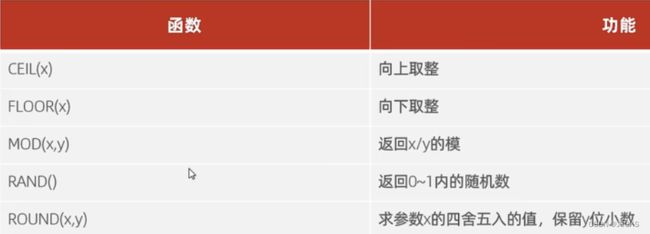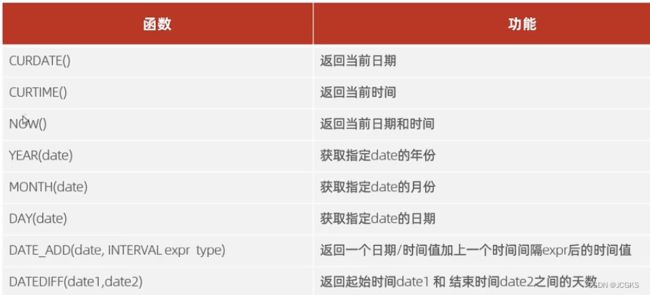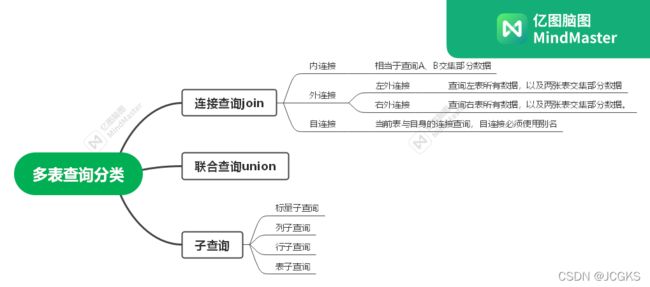MySQL常用命令1
文章目录
- SQL分类
-
- DDL
-
- 数据库
- 数据库中的表
- DML
- DQL
- DCL
- 函数
- 约束
- 多表查询
-
- 多表关系
- 多表查询概述
- 内连接
- 外连接
- 自连接
- 联合查询
- 子查询
-
-
- 标量子查询
- 列子查询
- 行子查询
- 表子查询
-
- 多表查询案例
- 事务
-
- 事务简介
- 事务操作
- 事务隔离级别
SQL分类
DDL
数据库
- 查询所有数据库
show databases;
- 查询当前数据库
select DATABASE();
- 创建数据库
create DATABASE [if not exists] db_name [Default charset 字符集][COLLATE 排序规则]
- 删除数据库
drop database [if exists] db_name;
- 使用数据库
use db_name;
数据库中的表
- 查询当前数据库所有表
show tables;
- 查询表结构
desc table_name;
- 查询指定表的建表语句
show create table table_name;
- 表操作
create table table_name(
字段1 字段1类型[comment 字段1注释],
字段2 字段2类型[comment 字段2注释],
.......
字段n 字段n类型[comment 字段n注释]
)[comment表注释];
alter table table_name add 字段名 类型(长度)[comment 注释][约束];
- 修改数据类型
alter table table_name modify 字段名 新数据类型(长度);
- 修改字段名和字段类型
alter table table_name CHANGE 旧字段名 新字段名 类型(长度) [comment 注释] [约束];
- 删除字段
alter table table_name drop 字段名;
- 修改表名
alter table table_name rename to 新表名;
- 删除表
drop table [if exists] 表名;
- 删除指定表,并重新创建该表
truncate table table_name;
DML
- 给指定字段添加数据
insert into table_name(字段名1,字段名2)values(值1,值2);
- 给全部字段添加数据
insert into table_name values(值1,值2,..);
- 批量添加数据
insert into table_name(字段名1,字段名2)values(值1,值2),(值1,值2),(值1,值2);
insert into table_name values(值1,值2,..),(值1,值2,..);
#字符串和日期类型数据应该包含在引号中
#插入的数据大小应该在字段的规定范围内
- 修改数据
update table_name set 字段名1=值1,字段名2=值2,...[where 条件];
- 删除数据
delete from table_name [where 条件];
# delete语句不能删除某一个字段可以用update
DQL
- 基本语法
select 字段列表 from 表名 where 条件列表;
- 聚合函数
# 将一列数据作为一个整体,进行纵向计算
# count : 统计数量
# max : 最大值
# min : 最小值
# avg : 平均值
# sum : 求和
select 聚合函数(字段) from table_name;
# null值不参数所有聚合函数运算
- 分组查询
select 字段列表 from 表名 [where 条件] group by 字段名[having 分组过滤后条件];
where 与 having 的区别
1.执行时机不同:where是分组之前进行过滤,不满足where条件,不参与分组;而having是分组之后对结果进行过滤。
2.判断条件不同:where不能对聚合函数进行判断,having可以。
3.执行顺序:where>聚合函数>having
4.分组之后,查询的字段一般是聚合函数和分组字段,查询其它字段不合法也没有任何意义
- 排序查询
select 字段列表 from table_name order by 字段1 排序方式1 , 字段2 排序方式2;
# asc升序(默认)desc降序
- 分页查询
select 字段列表 from 表名 limit 起始索引 , 查询记录数;
# 起始索引从0开始,起始索引=(查询页码-1)*每一页记录数
# 分页查询是数据库的方言
# 如果查询的是一页数据,起始索引可以省略,直接简写为limit 10;
DCL
DCL(Data Control Language),用来管理数据库用户、控制数据库访问权限。
- 查询用户
use mysql;
select * from user;
- 创建用户
create user '用户名'@'主机名' identified by '密码';
- 修改用户密码
alter user '用户名'@'主机名' indetified with mysql_native_password by '新密码';
- 删除用户
drop user '用户名'@'主机名';
show grants for '用户名'@'主机名';
- 授予权限
grant 权限列表 on 数据库名.表名 to '用户名'@'主机名';
- 撤销权限
revoke 权限列表 on 数据库名.表名 from '用户名'@'主机名';
函数
约束
- 外键约束
create table table_name(
字段名 数据类型;
[constraint] [外键名称] foreign key [外键字段名] references 主表(主表列名);
);
alter table table_name add constraint 外键名称 foreign key (外键字段名) references 主表(主表字段);
alter table table_name add constraint 外键名称 foreign key (外键字段名) references 主表(主表字段)
on update cascade on delete cascade;
多表查询
多表关系
项目开发中,在进行数据库表结构设计时,会根据业务需求及业务模块之间的关系,分析并设计表结构,由于业务之间相互关联,所以各个表结构之间也存在着各种联系,基本上分为三种:
- 一对多(多对一)
案例:部门与员工的关系
关系:一个部门对应多个员工,一个员工对应一个部门
实现:在多的一方建立外键,指向一的一方的主键。
部门表
mysql> create table dept(
-> id int primary key auto_increment comment '编号ID',
-> name varchar(50) not null comment '部门名称'
-> )comment '部门表';
员工信息表
mysql> create table emp(
-> id int primary key auto_increment comment 'ID',
-> name varchar(50) not null comment '姓名',
-> age int default null comment '年龄',
-> job varchar(20) default null comment '职位',
-> salary float default null comment '薪资',
-> entrydate date default null comment '入职时间',
-> managerid int default null comment '直属领导ID',
-> dept_id int default null comment '部门ID',
-> constraint fk_deptid foreign key (dept_id) references dept(id)
-> );
插入数据
mysql> insert into dept (name) values
-> ('研发部'),
-> ('市场部'),
-> ('财务部'),
-> ('销售部'),
-> ('总经办'),
-> ('人事部');
mysql> insert into emp values
-> (null,'金庸',66,'总裁',20000.0,'2000-01-01',null,5),
-> (null,'张无忌',20,'项目经理',12500.0,'2005-12-05',1,1),
-> (null,'杨逍',33,'开发',8400.0,'2000-11-03',2,1),
-> (null,'韦一笑',48,'开发',11000.0,'2002-02-05',2,1),
-> (null,'常遇春',43,'开发',10500.0,'2004-09-07',3,1),
-> (null,'小昭',19,'程序员鼓励师',6600.0,'2004-10-12',2,1),
-> (null,'灭绝',60,'财务总监',8500.0,'2002-09-12',1,3),
-> (null,'周芷若',19,'会计',48000.0,'2006-06-02',7,3),
-> (null,'丁敏君',23,'出纳',5250.0,'2009-05-13',7,3),
-> (null,'赵敏',20,'市场部总监',12500.0,'2004-10-12',1,2),
-> (null,'鹿仗客',56,'职员',3750.0,'2006-10-03',10,2),
-> (null,'鹤笔翁',19,'职员',3750.0,'2007-05-09',10,2),
-> (null,'方东白',19,'职员',5500.0,'2009-02-12',10,2),
-> (null,'张三丰',88,'销售总监',14000.0,'2004-10-12',1,4),
-> (null,'俞莲舟',38,'销售',4600.0,'2004-10-12',14,4),
-> (null,'宋远桥',40,'销售',4600.0,'2004-10-12',14,4),
-> (null,'陈友谅',42,null,2000.0,'2011-10-12',1,null);
- 多对多
案例:学生与课程的关系
关系:一个学生可以选修多门课程,一门课程也可以供多个学生选择。
实现:建立第三张中间表,中间表至少包含两个外键,分别关联两方主键
学生表
mysql> create table student (
-> id int auto_increment primary key comment '主键ID',
-> name varchar(10) comment '课程名称',
-> no varchar(10) comment '学号'
-> )comment '学生表';
课程表
mysql> create table course(
-> id int auto_increment primary key comment '主键ID',
-> name varchar(10) comment '课程名称'
-> )comment '课程表';
学生课程中间表
mysql> create table student_course(
-> id int auto_increment primary key comment '主键',
-> studentid int not null comment '学生ID',
-> courseid int not null comment '课程ID',
-> constraint fk_courseid foreign key (courseid) references course(id),
-> constraint fk_studentid foreign key (studentid) references student(id)
-> )comment '学生课程中间表';
插入数据
insert into student(name,no) values
('张三','2000100101'),
('李四','2000100102'),
('王五','2000100103'),
('小六','2000100104');
insert into course (name)values
('Java'),('PHP'),('MySQL'),('Hadoop');
insert into student_course(studentid,courseid) values
(1,1),(1,2),(1,3),(2,2),(2,3),(3,4);
- 一对一
案例:用户与用户详情的关系
一对一关系,多用于单表拆分,将一张表的基础字段放在一张表中,其它详情字段放在另一张表中,以提升操作效率。(用户基本信息表tb_user,用户教育信息表tb_user_edu)
实现:在任意一方加入外键,关联另外一方的主键并设置外键为唯一的(UNIQUE)
用户基本信息表
mysql> create table tb_user(
-> id int auto_increment primary key comment '主键ID',
-> name varchar(10) comment '姓名',
-> age int comment '年龄',
-> gender char(1) comment '1:男 2:女',
-> phone char(11) comment '手机号'
-> )comment '用户基本信息表';
用户受教育信息表
mysql> create table tb_user_edu(
-> id int auto_increment primary key comment '主键ID',
-> degree varchar(20) comment '学历',
-> major varchar(50) comment '专业',
-> primaryschool varchar(50) comment '小学',
-> middleschool varchar(50) comment '中学',
-> university varchar(50) comment '大学',
-> userid int unique comment '用户ID',
-> constraint fk_userid foreign key (userid) references tb_user(id)
-> )comment '用户教育信息表';
插入数据
mysql> insert into tb_user values(null,'黄渤',45,'1',18800001111),
-> (null,'冰冰',35,'2','18800001122'),
-> (null,'码云',55,'1','18800001133'),
-> (null,'李云',50,'1','18800001144');
mysql> insert into tb_user_edu values(null,'本科','舞蹈','静安区第一小学','静安区第一中学','北京舞蹈学院',1),
-> (null,'硕士','表演','朝阳区第一小学','朝阳区第一中学','北京电影学院',2),
-> (null,'本科','英语','杭州市第一小学','杭州市第一中学','杭州师范大学',3),
-> (null,'本科','应用数学','阳泉区第一小学','阳泉区第一中学','清华大学',4);
多表查询概述
- 概述:指从多张表中查询数据
- 笛卡尔积:笛卡尔乘积是指在数学中,两个集合A和B的所有组合情况(在多表查询时需要消除无效的笛卡尔积)。
-- 消除无效的笛卡尔积
SELECT * from emp,dept where emp.dept_id = dept.id ORDER BY emp.id;
内连接
- 隐式内连接
select 字段列表 from 表1,表2 where 条件....;
- 显示内连接
select 字段列表 from 表1 [INNER] JOIN 表2 on 连接条件...;
查询每一个员工的姓名,及关联的部门的名称(隐式内连接实现)
select emp.name '员工姓名',dept.name '部门名称' from emp,dept where emp.dept_id = dept.id;
查询每一个员工的姓名,及关联的部门的名称(显示内连接实现)
select emp.name '员工姓名',dept.name '部门名称' from emp inner join dept on emp.dept_id = dept.id;
当表名很长的时候给表起一个别名
select e.name,d.name from emp e,dept d where e.dept_id = d.id;
外连接
- 左外连接
select 字段列表 from 表 LEFT [OUTER] JOIN 表2 on 条件 ....;
- 右外连接
select 字段列表 from 表 RIGHT [OUTER] JOIN 表2 on 条件 ....;
查询emp表的所有数据,和对应的部门信息(左外连接)
select e.*,d.name from emp e LEFT JOIN dept d on e.dept_id = d.id;
查询dept表的所有数据,和对应的员工信息(右外连接)
select e.*,d.name from emp e RIGHT JOIN dept d on e.dept_id = d.id;
自连接
select 字段列表 from 表A 别名A [inner|left|right]join 表B 别名B on 条件
查询员工及其所属领导的名字
-- e表是员工表 ee是领导表--
select e.name '员工',ee.name '领导' from emp e inner JOIN emp ee on e.managerid = ee.id;
查询所有员工emp及其领导的名字,如果员工没有员工,也要查询。
select e.name '员工',ee.name '领导' from emp e left JOIN emp ee on e.managerid = ee.id;
联合查询
select 字段列表 from 表A ... union[ALL] select 字段列表 from 表B.....
将薪资低于5000的员工,和年龄大于50岁的员工全部查出来
select name from emp where salary<5000 union all --会出现重复的结果--
select name from emp where age>50;
select name from emp where salary<5000 union --不会出现重复的结果--
select name from emp where age>50;
- 对于联合查询的多张表的列数必须把保持一致,字段类型也需要保持一致。
子查询
概念:SQL语句中嵌套select语句,称为嵌套查询(子查询)
select * from t1 where column1 = (select column1 from t2);
子查询外部的语句可以是insert、update、delete、select中的任何一个。
标量子查询
子查询返回的结果为单个值(数字、字符串、日期等)
常用的操作符:=、<>、>、>=、<、<=
查询“销售部”的所有员工信息
select * from emp where dept_id = (select id from dept where name = "销售部" );
查询在“方东白”入职之后的员工信息
select * from emp where entrydate > (select entrydate from emp where name="方东白");
列子查询
子查询结果是一列(可以是多行)。
常用的操作符:IN、NOT IN、ANY、SOME、ALL
IN:在指定的集合范围之内,多选一
NOT IN:不在指定的集合范围内
ANY:子查询返回列表中,有任意一个满足即可
SOME:与ANY等同
ALL:子查询返回列表的所有值都必须满足。
查询“销售部”和“市场部”的所有员工信息
select * from emp where dept_id in (select id from dept where name in ('销售部','市场部'));
查询比财务部所有人工资都高的员工信息
select * from emp where salary > all (select salary from emp where dept_id = (select id from dept where name = "财务部"));
查询比研发部其中任意一人工资高的员工信息
select * from emp where salary > any (select salary from emp where dept_id = (select id from dept where name = "研发部"));
行子查询
子查询返回的结果是一行(可以是多列)。
常用的操作符:=、<>、in、not in。
查询与“张无忌”的薪资及直属领导相同的员工信息。
select * from emp where (salary,managerid) = (select salary,managerid from emp where name = '张无忌');
表子查询
子查询结果是多行多列。
常用的操作符是in。
表子查询经常出现在from之后,表子查询返回的结果作为一张临时表再和其他表进行联查操作。
查询与“鹿仗客”、"宋远桥"的职位和薪资相同的员工信息。
--子查询返回一张临时表--
select * from emp inner join (select job,salary from emp where name in('鹿仗客','宋远桥')) d where emp.job = d.job and emp.salary = d.salary;
简单写法
select * from emp where (job,salary) in (select job,salary from emp where name='鹿仗客' or name='宋远桥');
查询入职日期是“2006-01-01”之后的员工信息,及其部门信息。
select e.*,d.name from (select * from emp where entrydate > '2006-01-01') e left join dept d on e.dept_id = d.id;
select d.name,e.* from dept d right join (select * from emp where entrydate>'2006-01-01') e on e.dept_id = d.id;
多表查询案例
一共需要三个表emp、dept、salgrade
mysql> create table salgrade(
-> grade int,
-> losal int,
-> hisal int
-> )comment '薪资等级表';
mysql> insert into salgrade values (1,0,3000),
-> (2,3001,5000),
-> (3,5001,8000),
-> (4,8001,10000),
-> (5,10001,15000),
-> (6,15001,20000),
-> (7,20001,25000),
-> (8,25001,30000);
1-3 内连接
- 查询员工的姓名,年龄,职位,部门信息(隐式内连接)
select e.name,e.age,e.job,d.name from emp e,dept d where e.dept_id = d.id;
- 查询年龄小于30岁的员工的姓名,年龄,职位、部门信息(显示内连接)
select e.name,e.age,e.job,d.name from (emp e inner join dept d on e.dept_id = d.id) where e.age<30;
select e.name,e.age,e.job,d.name from emp e inner join dept d on e.dept_id = d.id where e.age<30;
- 查询拥有员工的部门ID、部门名称。
select distinct d.* from dept d inner join emp e on d.id = e.dept_id;
- 查询所有年龄大于40岁的员工,及其所属的部门名称;如果没有分配部门,也需要展示出来
select e.*,d.name from emp e left join dept d on e.dept_id = d.id where e.age>40;
- 查询所有员工的工资等级
涉及到的表emp、salgrade
连接条件:e.salary >= s.losal && e.salary <= s.hisal
select e.* ,s.grade from emp e ,salgrade s where s.losal <= e.salary and e.salary<=s.hisal;
select e.* ,s.grade from emp e ,salgrade s where e.salary between s.losal and s.hisal;
- 查询“研发部”所有员工的信息及工资等级
--先筛选出研发部的部门信息,再去匹配等级--
select e.*,s.grade from (select * from emp where emp.dept_id = (select id from dept where name='研发部')) e join salgrade s on e.salary between s.losal and s.hisal;
--先匹配等级,在筛选出研发部的信息--
select e.*,s.grade from (emp e inner join salgrade s on e.salary between s.losal and s.hisal) where e.dept_id=(select id from dept where name = '研发部');
--三张表一起连接--
select e.* , s.grade from emp e,dept d,salgrade s where e.dept_id=d.id and (e.salary between s.losal and s.hisal) and d.name="研发部";
- 查询“研发部”员工的平均工资
select avg(salary) '研发部平均工资' from emp e group by dept_id having dept_id = (select id from dept where name ='研发部');
select avg(e.salary) from emp e,dept d where e.dept_id = d.id and d.name = '研发部';
- 查询工资比“灭绝”高的员工信息
select * from emp where salary > (select salary from emp where name = '灭绝');
- 查询比平均薪资高的员工信息
select * from emp where salary > (select avg(salary) from emp);
- 查询低于本部门平均工资的员工信息
select e.* from emp e where e.salary < (select avg(e1.salary) from emp e1 group by e1.dept_id having e1.dept_id = e.dept_id );
- 查询所有的部门信息,并统计部门的人数
select d.*,count(e.dept_id) from dept d left join emp e on d.id=e.dept_id group by e.dept_id;
select d.id,d.name,(select count(*) from emp e where e.dept_id = d.id) from dept d;
- 查询所有学生的选课情况,展示出学生名称,学号,课程名称
select s.name '学生姓名',s.no '学生学号',c.name '课程名称' from student s,course c,student_course sc where sc.studentid=s.id and sc.courseid=c.id;
事务
事务简介
事务是一组操作的集合,它是一个不可分割的工作单位,事务会把所有的操作作为一个整体一起向系统提交或撤销操作请求,即这些操作要么同时成功,要么同时失效。
事务操作
CREATE TABLE account (
id int(11) NOT NULL AUTO_INCREMENT COMMENT '编号ID',
name varchar(10) DEFAULT NULL COMMENT '姓名',
money int(11) DEFAULT NULL COMMENT '余额',
PRIMARY KEY (`id`)
) COMMENT='账户表'
insert into account (name,money) values('张三',2000),('李四',2000);
模拟转账操作
- 查询张三的余额
- 将张三账户的余额减1000
- 将李四账户的余额加1000
--查看事务提交方式--
select @@autocommit;--或者--
show variables like 'autocommit';
--设置事务提交方式--
set @@autocommit=0;
----
提交事务
commit;
回滚事务
rollback;
在不设置手动提交的前提下开启事务
开启事务
begin;
查看mysql文件在磁盘上的存储位置
show variables like '%datadir%';
事务隔离级别
读未提交 read uncommitted
读已提交read committed
可重复读repeatable read
串行化serializable
查看事务隔离级别
select @@tx_isolation;
select @@global.tx_isolation;
设置隔离级别
set session transaction isolation level 隔离级别;
set global transaction isolation level 隔离级别;














